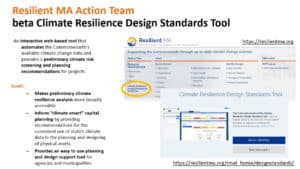Hoping to be better prepared for the climate and environmental hazards of the future, the Baker administration launched a tool Wednesday to allow cities and towns to assess the climate change risk level of planned projects and get recommendations to make the designs more resilient.
The Resilient MA Action Team Climate Resilience Design Standards Tool aims to get municipal leaders to think about how climate change over the coming decades might affect developments that are still in the planning stages and for the state to share mitigation recommendations.
“You can’t build the infrastructure the same way it was designed 50 years ago. You need to think about the best practices and the strategies that are involved with building resilient infrastructure for the future. And that’s where this design standards tool comes into play,” Lt. Gov. Karyn Polito said. “So you don’t have to figure that out. You can literally understand what the risk is associated with your infrastructure. We can share the design standards with you. There are guidelines around best practices and these can be incorporated into, literally, into your communities.”
Though intended initially for state-funded capital projects, state officials said, the tool is a resource for all municipalities and practitioners, and can be used to assess climate risks for building, infrastructure or natural resource projects with physical assets. Energy and Environmental Affairs Secretary Kathleen Theoharides and other officials said the tool will be particularly helpful to cities and towns as they go through local planning exercises and when they apply for funding to state grant programs like the Municipal Vulnerability Preparedness program.
“This project is particularly exciting because it represents sort of making the state hazard mitigation and climate adaptation plan in action, it’s a key action from that plan,” the secretary said. “And it will help us with something we have heard from many communities, that we need a tool that gives us consistent design standards across agencies and for cities and towns to use when they are thinking about building something, not for the past but for the future and for a future where we’re seeing more frequent storms, higher seas, sea level rise and intensity.”
Beverly Mayor Michael Cahill said projects the city has underway “most definitely will benefit” from the state’s new tool, which launched in a beta form with state officials asking for feedback to perfect it in the coming months.
“It’s exciting to think of. We’re in the process of finishing construction on a brand-new police station in Beverly … On the adaptation and resilience concerns, out of necessity we are building the station in a 100-year floodplain,” Cahill said. “What we did right away was we did all the analysis and we ended up raising the site by 6 feet to get above the 100-year flood elevation by a good amount, building a station to be slab on grade, creating it so that it goes down to the surrounding area and the parking, and building a lot of durable materials into the first-floor construction – all in preparation for that storm event, which we hope won’t come and we’re trying to try to prepare appropriately for.”
The online tool asks for a series of inputs, including the project’s location, cost, purpose and expected useful lifetime. It also asks about previous flooding at the site, whether trees will be removed and other questions that lend context to the project site.
The tool then incorporates the state’s most updated climate data to assess the potential climate change-related risks of the project and to make recommendations for ways the project design could be changed to improve the site’s resilience.
Late last month, Theoharides told state budget writers that the administration’s Municipal Vulnerability Preparedness grant program has now enrolled 89 percent of all municipalities but will not be able to keep up with the funding necessary to address climate adaptation. For the most recent round, the program got $45 million worth of requests and had just $10.45 million to allocate.
“We’ve seen the need, again and again, to build resilient communities to prepare in advance for that next big storm and to help our environmental justice communities that are least able to adapt to a changing climate access funding and support to protect our most vulnerable residents. Our MVP program has been incredibly successful, but the current funding mechanism is simply not enough,” she told the Joint Ways and Means Committee. “Cities and towns across Massachusetts are in dire need of funding and assistance to protect their residents from the impacts of climate change, and a dedicated predictable revenue stream is a critical tool in protecting our most vulnerable populations.”




 |
| 


